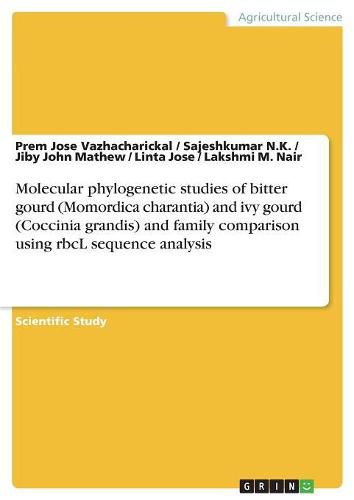Readings Newsletter
Become a Readings Member to make your shopping experience even easier.
Sign in or sign up for free!
You’re not far away from qualifying for FREE standard shipping within Australia
You’ve qualified for FREE standard shipping within Australia
The cart is loading…






Scientific Study from the year 2017 in the subject Agrarian Studies, Mar Augusthinose College, language: English, abstract: The Cucurbitaceae family is the one of the economically important groups of plants in the tropics and subtropics. Molecular phylogenetic analysis was advanced after the introduction of molecular markers which give much precise results in analysis. Our current study based on the amplification of RuBisco enzyme using rbcL primer and subsequent validation using BLAST, FASTA and CLUSTAL-W in pumpkin and winter melon. The isolated and purified DNA samples were PCR amplified using rbcL primer and later sequenced using ABI Prism 377 DNA sequencer. Multiple sequence alignment algorithms and distance matrix were constructed using rbcL sequences in FASTA format were retrieved from GenBank. Phylogenetic tree was created using the distance based neighbour joining (NJ) and clustering algorithms method. The agarose gel electrophoresis were used to separate the isolated as well as PCR amplified DNA samples. The sequences obtained after sequencing were subjected to BLAST similarity search and multiple sequence alignment using CLUSTAL-W. The construction of divergence matrix and phylogenetic dendrograms revealed two main groups, one consisting of MC and other Momordica species while the other group consisted of three subgroups of CM, CG and BH having members of Cucurbita, Coccinia and Momordica respectively. The reliability of molecular phylogenesis can be affected by myriad, long branch attraction, saturation and taxon sampling problems. So the selection of the models plays a key step in the success analysis. In general, the present study unambiguously confirmed the existence of Coccinia grandis as a distinct species and morphologic separation between Coccinia grandis and other selected members of Cucurbitaceae as separate species was evident. Among the species included in the present study Coccinia grandis undergone maximum divergence during the process
$9.00 standard shipping within Australia
FREE standard shipping within Australia for orders over $100.00
Express & International shipping calculated at checkout
Scientific Study from the year 2017 in the subject Agrarian Studies, Mar Augusthinose College, language: English, abstract: The Cucurbitaceae family is the one of the economically important groups of plants in the tropics and subtropics. Molecular phylogenetic analysis was advanced after the introduction of molecular markers which give much precise results in analysis. Our current study based on the amplification of RuBisco enzyme using rbcL primer and subsequent validation using BLAST, FASTA and CLUSTAL-W in pumpkin and winter melon. The isolated and purified DNA samples were PCR amplified using rbcL primer and later sequenced using ABI Prism 377 DNA sequencer. Multiple sequence alignment algorithms and distance matrix were constructed using rbcL sequences in FASTA format were retrieved from GenBank. Phylogenetic tree was created using the distance based neighbour joining (NJ) and clustering algorithms method. The agarose gel electrophoresis were used to separate the isolated as well as PCR amplified DNA samples. The sequences obtained after sequencing were subjected to BLAST similarity search and multiple sequence alignment using CLUSTAL-W. The construction of divergence matrix and phylogenetic dendrograms revealed two main groups, one consisting of MC and other Momordica species while the other group consisted of three subgroups of CM, CG and BH having members of Cucurbita, Coccinia and Momordica respectively. The reliability of molecular phylogenesis can be affected by myriad, long branch attraction, saturation and taxon sampling problems. So the selection of the models plays a key step in the success analysis. In general, the present study unambiguously confirmed the existence of Coccinia grandis as a distinct species and morphologic separation between Coccinia grandis and other selected members of Cucurbitaceae as separate species was evident. Among the species included in the present study Coccinia grandis undergone maximum divergence during the process